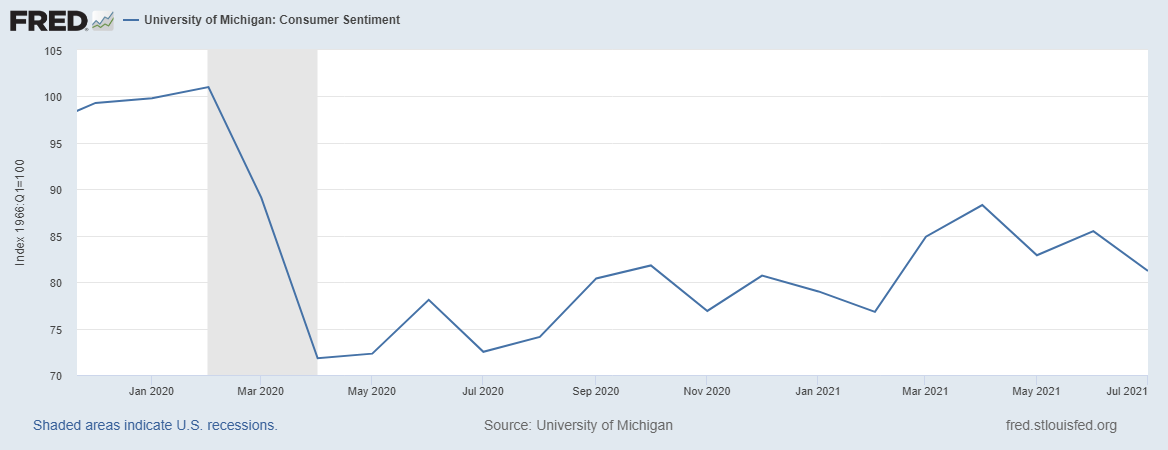Key Component of U.S. Economy Is Missing in Action
Let’s get one thing straight: the U.S. economy thrives on consumer spending. When consumer sentiment turns and consumers pull back on their spending, historically, that has never really ended well for the U.S. economy. A recession or dismal economic growth has almost always followed eventually.
With this, one has to ask, how are U.S. consumers doing at the moment? Surely, the stock market remains strong and is trending higher, and home prices have been surging.
However, if consumers aren’t happy, that impacts the U.S. economy directly. When consumers are happy, it’s a sign that they’ll spend their money. If they’re pessimistic, they’ll pull back on their spending.
Sadly, as it stands, consumer sentiment in the U.S. economy is subdued.
Look at the chart below. It plots the University of Michigan’s consumer sentiment index. It’s one of the most widely used indicators of consumer sentiment in the U.S.

(Source: “University of Michigan: Consumer Sentiment,” Federal Reserve Bank of St. Louis, last accessed September 8, 2021.)
In February 2020, the University of Michigan’s consumer sentiment index stood at over 100, suggesting that consumers were happy. Fast-forward to March 2020 and consumer sentiment in the U.S. started to plummet. Why? A pandemic had begun, and no one really knew what was next.
Here’s the kicker: by April 2020, the stock market had bottomed, the U.S. government had announced immense stimulus spending, interest rates dropped to zero, and the Federal Reserve began a massive money-printing job. One would assume that this would have improved consumer sentiment. It didn’t, and that’s scary.
What’s Next for the U.S. Economy?
It has been a few quarters now, and the consumer sentiment in the U.S. economy hasn’t improved much. Is it safe to say that consumer spending will take a hit?
There’s already evidence that consumers have been stepping back a little. Consider the U.S Advance Retail Sales data. Since April, retail sales in the U.S. have declined month-over-month twice. (Source: “Advance Retail Sales: Retail Trade,” Federal Reserve Bank of St. Louis, last accessed September 8, 2021.)
Dear reader, if consumer sentiment remains weak going forward, be very careful. It’s a risk that’s not getting much attention these days.
Going into 2021, the outlook for the U.S. economy was rosy. Everyone had projected great things. Investors bought stocks because they thought everything was perfectly fine and things would improve throughout the year.
I fear we’re going to see revisions to the U.S. economic growth forecast. It won’t just be the Federal Reserve revising its growth estimates for the U.S. economy lower; we could see big banks do the same.
Here’s some food for thought: once investors start paying attention to the economic data and, all of a sudden, realize that the U.S. economy could be slowing, what will they do? Will they assess their portfolios and sell their investments? Moreover, could an economic slowdown be in store for late 2021 and early 2022?






